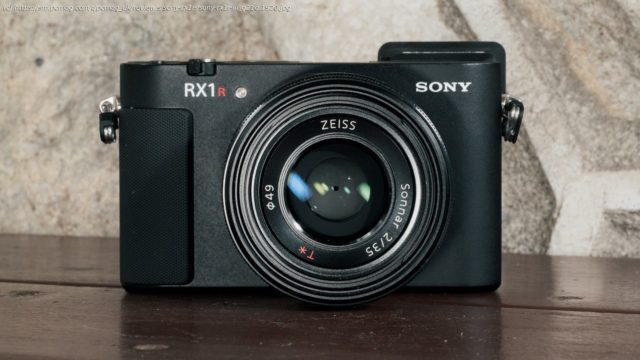The Sony RX1R III full-frame sensor camera is amazingly small and light, and its pictures are incredible, but it makes too many sacrifices in favor of its size to justify its luxury price.
The Sony RX1R III ($5,099.99) is an exotically priced compact camera aimed squarely at professional photographers, serious hobbyists, artists, and well-heeled tech enthusiasts who don’t mind paying a premium for miniaturization. It puts a 60MP full-frame sensor into a camera body that’s small enough to slip into oversized pockets, and features a 35mm F2 prime lens for snapshots with beautifully defocused backgrounds. I like its redesigned EVF, but am less enamored with the fixed rear display and underpowered battery, so I continue to recommend the Fujifilm X100VI as our Editors‘ Choice among premium compact cameras. The X100VI ($1,799.95) isn’t full-frame, and you might need to wait to get one (or be willing to pay above list price), but it tickles the same fancies, includes weather sealing, and features a hybrid optical-electronic viewfinder, all for about a third of the cost of the RX1R III. Design: The Smallest, Lightest Full-Frame Compact
Sony took nearly a full decade to update the RX1R II to the point where I questioned if we’d ever see a sequel. It’s common for a few years to pass between camera models, but eventually you just have to give up hope. But the RX1R II is a camera with a devoted following. I even spotted Sony’s US President and COO, Neal Manowitz, using an old RX1R II at the a9 III launch event in late 2023. I asked Neal about it, and he told me that the RX1R II was his everyday camera for a decade, but it has been replaced by an RX1R III. Clearly, the series has fans in high places.
The RX1R III features a redesigned body; it’s not simply a repackaging with a newer image sensor and processor, although both are upgraded. The RX1R II used the 42MP BSI CMOS chip and processing engine from one of its contemporary ILCs, the a7R II. The RX1R III also borrows from existing cameras, using the 60MP BSI CMOS imager and Bionz XR engine from the full-size a7R V and compact a7CR. The RX1R III drops the tilting display from the previous edition, but comes with an improved EVF, and uses the same lens, a 35mm F2 Zeiss Sonnar that dates back to the original RX1. All and all, the latest edition is faithful to the series‘ core concept, and should feel familiar enough for RX1 devotees.
That concept involves packing as large a sensor as possible into a reasonably small camera. It’s been copied by others, but full-frame competitors like the Leica Q3 and Q3 43 (3.2 by 5.1 by 3.7 inches, 1.7 pounds) are noticeably larger and heavier than the RX1R III (2.7 by 4.5 by 3.4 inches, 1.1 pounds). Its protruding 35mm F2 prime lens means that it’s not quite pocketable (winter coats and cargo pants aside), so look to the recent APS-C format sensor Ricoh GR IV (2.4 by 4.3 by 1.3 inches, 9.2 ounces) if you want a camera you can slip into your jeans.
Like similar cameras, the RX1R III uses a prime lens. Its 35mm F2 captures a moderately wide angle, and is a favored focal length for what I like to describe as slice-of-life images. It can capture portraits that incorporate some of the environment to give a sense of place, and focuses close enough for 1:3.8 macro magnification. And since the 60MP sensor has so much resolution, the RX1R III includes a crop mode, effectively giving it digital zoom for 50mm (29MP) and 70mm (15MP) capture. The Leica Q3 and Q3 43 also use 60MP sensors and offer a similar feature, as does the 40MP Fujifilm X100VI.
The RX1R III uses magnesium for its chassis and exterior, with a black anodized finish. Magnesium is tough, but lightweight, so it’s a sensible choice. The camera also includes a small handgrip and rear thumb rest, both of which are rubber with a texture that works to reduce the chances of it slipping out of your hand. It feels a little cramped to me, but there are add-ons available to make the camera more comfortable. The Sony TG-2 Thumb Grip ($299.99) adds a better sculpted thumb rest to the rear, and you can go with a third-party option like the Wooden Sony RX1R III Grip ($137) or Sony’s LCS-RXL Body Case ($249.99) if you prefer a larger front grip. I didn’t get to try any of these during my review, so I can’t speak to how they change the feel of the camera.
Sony does not include weather sealing in the RX1R III, which is disappointing given its price and appeal as a travel camera. I wouldn’t hesitate to take it out for photos in light rain, but you’ll want to stow it in a bag if you get caught in a downpour. This is one area where the pricier Leica Q3 and Q3 43 win out, as both are rated to IP52 standards. The Fujifilm X100VI is partially weather-sealed out of the box and fully protected if you add a protective lens filter.Controls: Everything You Need at Your Fingertips
The RX1R III may be small, but it leaves room enough for the tactile controls to satisfy experts, and includes automatic operation for visual artists who may not have as much technical know-how when it comes to ISOs and f-stops.
The top plate includes discrete dials to set the capture mode and adjust EV compensation to brighten or darken a scene. There’s also a Custom (C1) button that cycles through digital zoom settings by default, but may be reconfigured via the menu. The shutter release is on top in its expected place, and is ringed by the On/Off toggle. The shutter includes a thread that works with soft release buttons and mechanical release cables.
The rear includes AF-ON/Magnify, C2, Fn, Menu, Play, and Delete/C3 buttons, along with two command dials. The topmost dial sets the shutter speed, and the flat rear dial is used for menu navigation and to scroll through pictures during playback. The latter also supports directional presses to toggle exposure information (Disp.) and adjust the sensor sensitivity (ISO).
There are also a couple of on-lens controls. The permanently affixed 35mm F2 includes an aperture ring that goes from f/2-16 with third-stop clicks (there’s no option for clickless operation), along with a ring to change between the macro (0.2-0.35m) and standard (0.3m-infinity) focus ranges, plus a manual focus ring, an arrangement that’s unchanged from earlier models in the series. I’m sure that longtime RX1 users will find it comfortable, though I tend to fumble around and twist the wrong ring when I’m trying to set the f-stop or focus range. I wish Sony had done more to make them feel a bit different, because as it stands, they have the same type of knurled ridges.
The manual focus experience is a mixed bag to me. I like that the focus ring responds without discernible lag, and that it features a nonlinear response so you can rapidly drive from close to distant subjects by turning it quickly, and use slower, deliberate movement for fine focus. But the EVF isn’t quite sharp enough for me to nail focus without turning on automatic frame magnification, and since the lens isn’t stabilized, the punched-in view shows every little bit of handshake, leading to jitter when trying to focus. Focus Peaking, which draws a colored highlight around the plane of focus, is available too, but I don’t find it accurate enough to nail focus with the 60MP sensor. Autofocus works quite well (more on that below), but can struggle in darker environments.
The menu system is refreshed so it’s consistent with Sony’s current line of interchangeable lens cameras.






